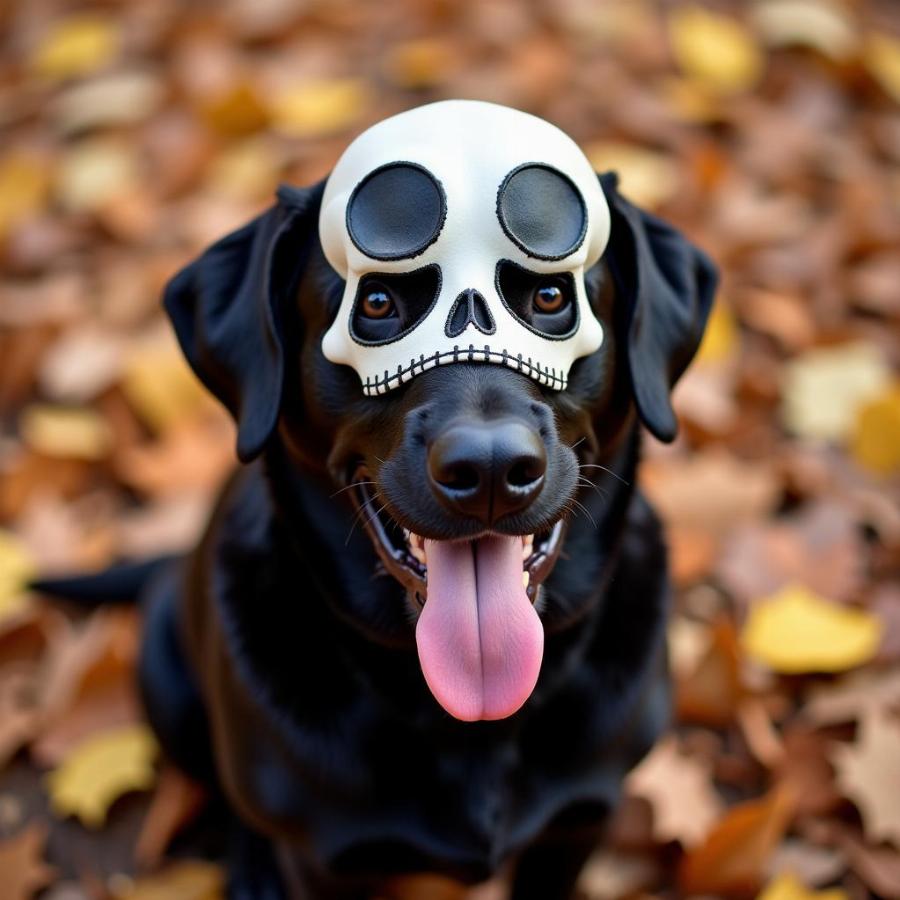The term “dog skull mask” might conjure unsettling images, but it’s important to understand its various contexts within the world of canine enthusiasts. While it might seem alarming at first glance, “dog skull mask” doesn’t always refer to something dark or sinister. In fact, it’s often related to harmless costumes, playful accessories, or even educational tools for veterinary students. This article delves into the multifaceted world of “dog skull masks,” separating myth from reality and providing a comprehensive understanding of this intriguing topic.
Decoding the Search: What are People Looking for?
When someone types “dog skull mask” into a search engine, their intent could vary widely. They might be:
- Pet owners: Searching for Halloween costumes, spooky accessories, or quirky apparel for their furry friends.
- Veterinary professionals or students: Looking for anatomical models to aid in their studies or practice.
- Curious individuals: Intrigued by the term itself and seeking to understand its meaning and implications.
Understanding these diverse motivations is key to providing relevant and informative content.
Dog Skull Masks for Dress-Up: Fun or Frightening?
Halloween costumes are a popular reason behind the search for “dog skull masks.” From playful pups dressed as pirates to spooky canines channeling their inner werewolf, the options are endless. However, it’s crucial to prioritize your dog’s comfort and safety.
Choosing the Right Mask:
- Fit and breathability: Ensure the mask fits comfortably and allows for proper breathing and panting.
- Material: Opt for non-toxic, durable materials that won’t irritate your dog’s skin.
- Visibility: The mask should not obstruct your dog’s vision or hearing.
 Dog in Skull Mask for Halloween
Dog in Skull Mask for Halloween
Remember: Not all dogs enjoy wearing costumes. If your dog shows signs of stress or discomfort, it’s best to skip the mask altogether.
Beyond Costumes: Anatomical Models and Educational Tools
“Dog skull masks” can also refer to realistic replicas used for educational purposes. Veterinary students, for instance, might use these models to study canine skull anatomy, bone structure, and dental formations. These models offer a hands-on learning experience, allowing students to visualize and understand complex anatomical details.
“Understanding the intricate details of a dog’s skull is crucial for diagnosing and treating various dental and cranial conditions,” says Dr. Emily Carter, a practicing veterinarian with over 15 years of experience. “These models serve as invaluable tools for aspiring veterinarians.”
Myths and Misconceptions: Separating Fact from Fiction
The term “dog skull mask” can sometimes be associated with negative connotations. However, it’s important to approach this topic with sensitivity and understanding.
- Cultural Significance: In some cultures, skulls hold spiritual or symbolic meaning and are not intended to be frightening. It’s essential to be respectful of these diverse interpretations.
- Responsible Use: Like any product, responsible use is key. “Dog skull masks,” whether costumes or educational tools, should never be used to promote fear, aggression, or animal cruelty.
Conclusion: Navigating the World of “Dog Skull Masks”
From playful Halloween costumes to valuable educational tools, the term “dog skull mask” encompasses a wide range of meanings and applications. By approaching this topic with an open mind and a focus on responsible use, we can appreciate the diverse contexts in which these masks exist. Remember, whether you’re dressing up your furry friend for Halloween or studying canine anatomy, prioritizing your dog’s well-being should always come first.
Frequently Asked Questions
1. Are dog skull masks safe for dogs to wear?
Yes, as long as the mask is well-fitting, made from non-toxic materials, and allows for proper breathing and visibility. Always supervise your dog while wearing a mask and remove it if they show signs of discomfort.
2. Where can I find high-quality anatomical dog skull models?
Reputable veterinary supply stores and online retailers specializing in medical models are good places to start.
3. What should I do if my dog seems scared of a dog skull mask?
Don’t force your dog to interact with the mask. Instead, try introducing it gradually and associating it with positive experiences like treats or praise. If your dog remains fearful, it’s best to avoid using the mask altogether.
4. Are there any alternatives to dog skull masks for Halloween costumes?
Absolutely! Consider less intimidating options like bandanas, hats, or costumes that don’t cover your dog’s face.
5. Are there any ethical concerns surrounding the use of dog skull masks?
The ethical implications depend largely on the context and intent. Responsible use, respect for cultural sensitivities, and prioritizing animal welfare are crucial considerations.
Explore More at Beaut Dogs
For more information on dog care, training, and responsible pet ownership, visit Beaut Dogs at https://beautdogs.com. We offer a wealth of resources to help you understand and care for your furry companion.
Need personalized advice? Contact our team of experts at [email protected]. We’re here to answer your questions and guide you on your journey as a responsible dog owner.